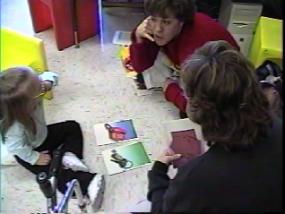Helping Maddie Learn New Words

Maddie sits on the floor with her regular teacher (foreground) and her speech teacher (in the back). The teachers use hand signs and words to ask Maddie to point to one of two pictures, the one for which the word and sign refer. Watch this video carefully. Here are some possible conclusions about what Maddie knows. Which ones do you accept? Cut and paste this text into a word document if you plan to purchase and download this five-minute video clip.
1. Maddie knows that words refer to pictures, but she does not treat the hand signs as symbols that represent pictures. Her use of hand signs look more imitative, except for a few cases such as the signs for truck and apple.
2. Maddie has a strong position bias, perhaps based on the sensory motor difficulty of pointing to a picture that is across the midline from her pointing hand. She might also think that the game is to find the side that makes the teachers applaud.
3. Maddie had trouble recognizing the phone picture. The pictured phone was too dissimilar from phones she has seen. She knows many word meanings (matching picture) but in some cases the picture is the problem, not her understanding of the way symbols work.
4. Maddie has some knowledge that pictured objects have definable parts, such as the tip of a pencil or the stem of an apple. Touching particular parts of the whole picture could suggest she is ready to learn the names of the parts and to realize that the general name does not refer to the part, e.g. apple versus stem, pencil versus tip.
5. Maddie does not know that she can get applause even if she does not know the word, i.e. by shifting to the other picture (aka, other side) if her first choice is wrong. One might reason that such a strategy requires a type of meta-knowledge about winning that is different from knowing. That is, she does not attempt to make clever guesses. If she does not know, she does not respond.
The naming exercises illustrated in this video are narrowly focused, structured, and teacher directed. At times, when new information is being offered, the child with special rights may need small moments such as these during which the new information is introduced and reviewed. These encounters are short in duration and are provided with the belief that the information gained in the \"structured\" moments can be integrated into the natural flow of the child\'s day, in play encounters with family, teachers and peers. What do you think? Would you use these methods if you had Maddie in your class? How might you modify this naming game? What additional approaches would you add to help Maddie communicate?
